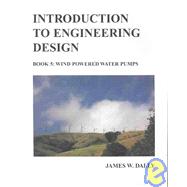Part I covers the product, a human powered water pump.
Chapter 1 Engineering Design and Product Development
Chapter 2 Wind Power
Chapter 3 Capturing the Wind
Chapter 4 The Drive Assembly
Chapter 5 Designing Pumps
Part II presents manual methods of engineering graphics.
Chapter 6 Three-View drawings
Chapter 7 Pictorial Drawing
Chapter 8 Tables and Graphs
Part III describes software programs useful to engineering students.
Chapter 9 Microsoft Excel -- 2000
Chapter 10 Microsoft Powerpoint -- 2000
Part IV discusses many aspects of the product development process.
Chapter 11 Development Teams
Chapter 12 A Product Development Process
Part V treats the very important topic of communications for engineers.
Chapter 13 Technical Reports Gathering
Chapter 14 Design Briefings
Part VI introduces the relation between engineering and society.
Chapter 15 Engineerin









